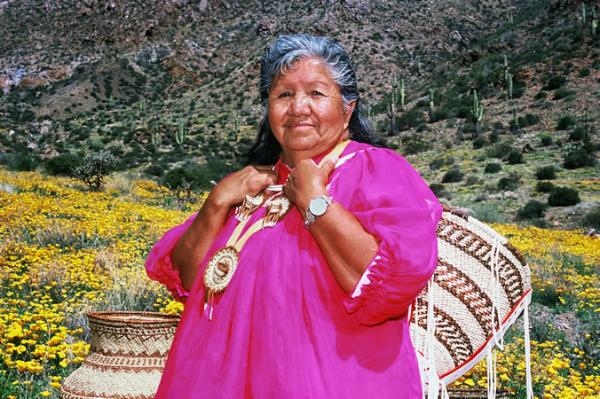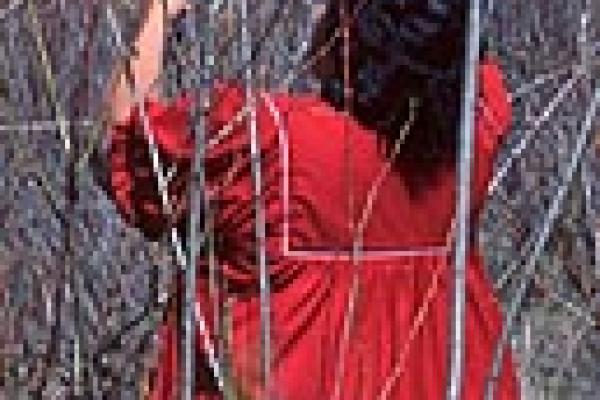Evalena Henry

Evalena Henry 2001. Photo by Tom Pich
Bio
The Ineh ("The People"), or the Apache, once occupied a large portion of the southwestern United States and northern Mexico. Because Apache bands were hunters and raiders who covered great distances on horseback and on foot, their basketry achieved a refined state of durability, functionality and beauty. The San Carlos Apache make three distinct basket types: coiled trays and plates; the tus, an urn-shaped water container; and the burden basket. Evalena Henry of Peridot, Arizona, is recognized as the master basketweaver among the San Carlos Apache. She learned from her mother, Cecilia Henry, who made baskets until she was 89. In the late 1970s, people began asking Evalena to make burden baskets for the Sunrise Dance, a coming of age ceremony for girls that has enjoyed a renaissance in recent years. These baskets must be beautiful and intricate, with the young woman's name sometimes woven as part of the design, as well as strong because many sacred objects are placed in the basket as part of the ceremony. Evalena continues to weave and to teach younger people basketweaving skills. Often the tribe will ask her to weave special baskets for official purposes and, while her baskets are much sought after by collectors and she has won numerous prizes throughout the region for her work, she still sees as her most important responsibility the time-consuming task of weaving ceremonial baskets, often for little or no remuneration.
 |
 |
Interview with Paul Carlson
NEA: Congratulations on your award. What was your reaction when you heard?
Henry: I'm still shocked. It's very exciting. I never expected this.
NEA: You should be very proud that you've been recognized. I know that you've worked very hard all your life to keep this tradition alive. Why do you think your artistry is valuable to your community?
Henry: Our art would die. On other reservations, the artists that used to make baskets are gone, tey're looking for somebody who still can pick it up again, or keep it going. We have a lot of reservations like that.
My mother is the one who started again in our area, back in about 1953. Her mother died when she was three years old, so she was raised by her grandmother. There was a cousin, too, who's mother had also died and they were both raised by the grandmother. The grandmother didn't have a real home, she just traveled on a horse. When she found willows of the sumac up in the mountains, she made baskets. There were Army camps in those years every so many miles, and whenever she made baskets, she traded them at the camps for food. Not for money, just food. She'd go down by herself and leave the girls behind, then she'd bring back the food. She didn't want the kids to go to school so she hid them, and they just traveled up in the mountains. They'd stay in a place for a few days, make baskets, then move on. She carried water and food with her on the horse along with the two girls. All those years my mother and her cousin saw this work, knew this work. They weren't that interested, but they did know how to do it. What materials to use, how she made the designs. They saw this through their teenage years.

NEA: Tell me about how you go about finding the willow you use.
Henry: In February, March, April everything gets green - it's kind of hard to weave at that time. But there's another reservation up in the mountains maybe sixty, seventy-five miles away from here - the White Mountain Reservation - where it's cold. So we go up there. Summer here in San Carlos is hot and it's hard to find the willows that you need. It's hard to find any colored ones. But up in the mountains we can find the black, maroon, gold, and green ones. So we go up there, the ladies pitch in -- sometimes we have to take a lunch with us.
If there's one growing up from the ground and if there's no twigs on it, if it's straight up, then that's the one we cut. We use about maybe eight colors of willows, and cottonwood.
August, September, October are very good, all the color comes back to the willows here. Right now the colors are real nice. There another place a couple of hours away close to Safford, Arizona, where we go. We have to look along the river there.
NEA: Are you teaching? Do you have students or young people that you are passing your tradition on to?
Henry: I taught at the Taos Art Institute [New Mexico] for a couple of years. There were four ladies very interested in weaving - white ladies from California, Australia, and Nevada and Oregon. A friend gave my name to the Institute and they called me to teach them. I went over there for a week. They made beautiful small baskets. Oh, they were so happy. They all made baskets and took them home.
I've been teaching at another reservation called Camp Verde here in Arizona. They don't have any art on their reservation and I've gone there every year for the past three years now, for two weeks. They've been calling me to different places to get their art going again. That's what I'm trying to do.
NEA: Do you have daughters who are learning the art?
Henry: Oh, yes, I have a daughter who makes real beautiful baskets. A lot of my grandkids know how to make them and my niece who's coming to DC with me who weaves the same way I do. She makes beautiful baskets. We're real close.
NEA: I noticed in the pictures that some of your baskets are very large. There was one with a long neck. What is something like that used for?
Henry: Yes, that's the "tus", with the design on it. It's mostly kept in the house for decoration. Then there's another kind with pitch on it that was used a long time ago to carry the water.
NEA: So that's woven tightly enough to hold water?
Henry: I have to put pinyon pine pitch on it, boil up pinyon pitch. That's very hard and very difficult work. I go up in the mountains and get the pitch. You clean it and boil it and I put in cedar leaves from the mountain cedar. I dry it, grind it and mix it with a red sand that I found up in the mountains. I grind it together and mix it with water and then cover the vase-shaped "tus" basket and let it dry overnight. After 24 hours I put a design on it with charcoal made from mesquite, charcoal that I grind on a rock with some water. It comes out like a black paint.
NEA: You use that to make the figures?
Henry: That's what I use and I just put it on the vase. On the neck part, the shoulder part - whichever way I want it - and it comes out real pretty.
NEA: I noticed on several of the baskets there are pictures of deer, and several had something called a Crown Dancer. What's the significance of the Crown Dancer? Does that have something to do with the Sunrise Ceremony?
Henry: It's a religious figure that we used to have a long time ago. They still use it up to this day. There's still a Crown Dancer that comes out to the ceremony to dance with the girl for the whole day. And that's where they use my baskets, too.
NEA: That's a coming-of-age ceremony?
Henry: Yes, for 11- or 12-year-old girls. Planning for this dance takes a whole year. The families save the money and the food for a whole year. It's a real expensive dance that they have here. That's when they use the Crown Dancer. I draw it on the baskets or on the vase.
NEA: Do you put the name of the girl on the basket sometimes?
Henry: Yes, I do.
NEA: Some of the baskets, the burden baskets, have what looks like pieces of leather or cloth. The long pieces - were they originally used to tie the basket onto a horse or a person?
Henry: It has to go around the shoulder. The long strap has to go across the shoulder and the basket goes on the back. A girl could put in acorns and tortillas, different kinds of breads they make, it all goes in there. Also, the fruit she had to carry to her godmother on her back during the dance. She gives it to the godmother and at that point the godmother adopts her like a daughter and has to take care of her from there on, to support her through all through her birthdays, through her wedding, whenever she has a child. It is very important that the girl carries this basket on her back. The one they use is my basket. I make them for the whole community here.
Another reservation called Mescalero in New Mexico ordered a basket and Camp Verde ordered a basket. All different reservations order them.
NEA: I noticed on some of your baskets a design that wasn't a deer or a dancer-it was a zigzag design that looked like it might have been mountain peaks. Was that the idea in that design?
Henry: Yes, sometimes I put zigzags in there. We have a mountain called "Triplet" that's a little ways from here that sometimes I draw on a basket. Or I might put butterflies on it, and running deer, fighting deer, standing deer, all kinds of deer.
NEA: What are you most looking forward to when you come to Washington?
Henry: Just to see Washington. I've never been on a plane before! And I've made a beautiful basket that says "Bill Ivey, 1998-2001." It's got a deer and a cactus on it and buckskin with fringes and jingles. It's a gift for him and it's going to be presented to him when I get my award.
NEA: I hope you have a good journey and we look forward to seeing you here.

